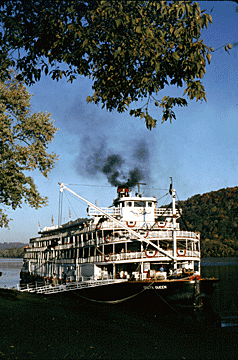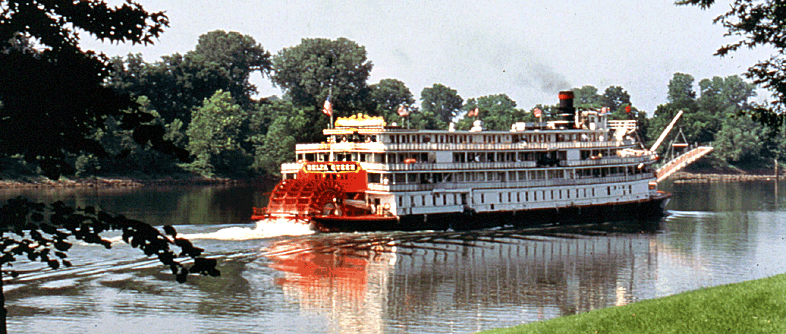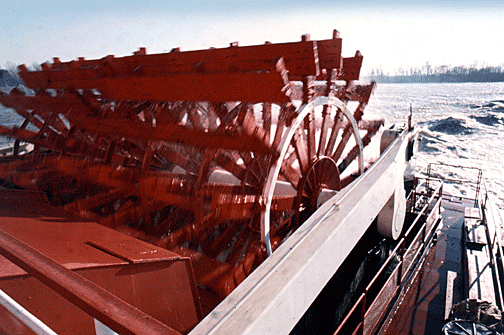 The sun is hot. The reflection off the river surface
is blinding. A slight breeze blows off the river. It's Saturday. It feels
good to be back out on the Ohio River again. It flows fast in its rush to
join the mighty Mississippi. I anxiously await the departure of the
steamboat Delta Queen from Cincinnati for a trip upriver to Pittsburgh--a
trip back in time. The sun is hot. The reflection off the river surface
is blinding. A slight breeze blows off the river. It's Saturday. It feels
good to be back out on the Ohio River again. It flows fast in its rush to
join the mighty Mississippi. I anxiously await the departure of the
steamboat Delta Queen from Cincinnati for a trip upriver to Pittsburgh--a
trip back in time.
The antebellum mansions across the water stand guard over
the waterway as they have for over a century. The air smells sweet and
clean--refreshing. The ship's bell gongs three times. It's whistle fills the
air with a powerful blow-me-away sound, "woo-ah, woo-ah, woo-ah, woooo-ah,"--several
short blasts then a long one. The trappings and stress of the 20th century
are beginning to melt away. The transformation has begun.
"All ashore that's going ashore," announces the
captain.
Soon the calliope begins to play. "Come on
along...toot, toot, boo, toot...passengers wave to friends on shore, flags
fly in the balmy air.
As we go under a bridge, the calliope echoes. The tune
changes to "Whistling Down the River," then "Beautiful
Ohio," "Pennsylvania Polka." Several passengers and I play
Name That Tune to the refrain of the "Beer Barrel Polka," songs
we'll hear again and again on our trip upriver.
Shipwrights built the 174-passenger Delta Queen, all four
decks of her, in 1926 at the Isherwood Shipyard on the River Clyde in
Glasgow, Scotland. They disassembled, boxed, shipped her to Stockton,
California. On May 20, 1927, her owners dedicated her. They say you could
get a dinner on board for 50 cents back then.
Steamboats have often been called the "front porch of
America." Quite an elaborate front porch, if you ask me. The Delta
Queen's interiors are rich with oak, teak, mahogany and Oregon cedar, with
stained glass windows and tapestries. Every cabin is different, decorated in
period antiques and immaculately kept. She's the real thing. Traveling
aboard her gives me the feeling of what it was like to board an overnight
steamer to St. Louis or Nashville.

The Greene family purchased the Delta Queen in 1946 for
$46,250, then spent nearly 3/4 million dollars refurbishing her. In June,
1948, she steamed downriver on her first cruise. The Greene family, under
the leadership of Captain Gordon Greene and his wife, Mary, invented the
river cruise. The Delta Queen sailed into a dream world of its own making,
with no telephone, no radio. The Greenes discovered a vacation formula that
has endured.
 Since that time, the Delta Queen Steamboat Company has
spent nearly $5 million in repairs and improvements. In truth, she's no
longer a 50-year-old passenger vessel. Every part of her from bilge to radar
mast, from stemplate to monkey rudder has been replaced or rebuilt. In the
process they've scrupulously maintained her antique character because she's
an important symbol of America's river heritage. Since that time, the Delta Queen Steamboat Company has
spent nearly $5 million in repairs and improvements. In truth, she's no
longer a 50-year-old passenger vessel. Every part of her from bilge to radar
mast, from stemplate to monkey rudder has been replaced or rebuilt. In the
process they've scrupulously maintained her antique character because she's
an important symbol of America's river heritage.
Some say Ma Greene's ghost prowls the boat. She became a
colorful river institution. A fiercely dedicated Presbyterian, she
prohibited the sale of alcoholic drinks on board. But Ma Greene gave in and
installed a bar after the death of her husband, Captain Gordon Greene.
Thirteen years later, a towboat named the Mary B(after her) went adrift at
Cincinnati and tore a hole in the Delta Queen exactly where the bar was
located.
In 1970, the Delta Queen achieved a place on the National
Register of Historic Places, which recognized it as the last operational
steam paddlewheeler with overnight accommodations plying the rivers of
America. The U.S. Department of the Interior designated the old
paddlewheeler as a National Historic Landmark. And in 2004, the grand old
girl finally made it into the National Maritime Hall of Fame.
Next: Part 2 |
